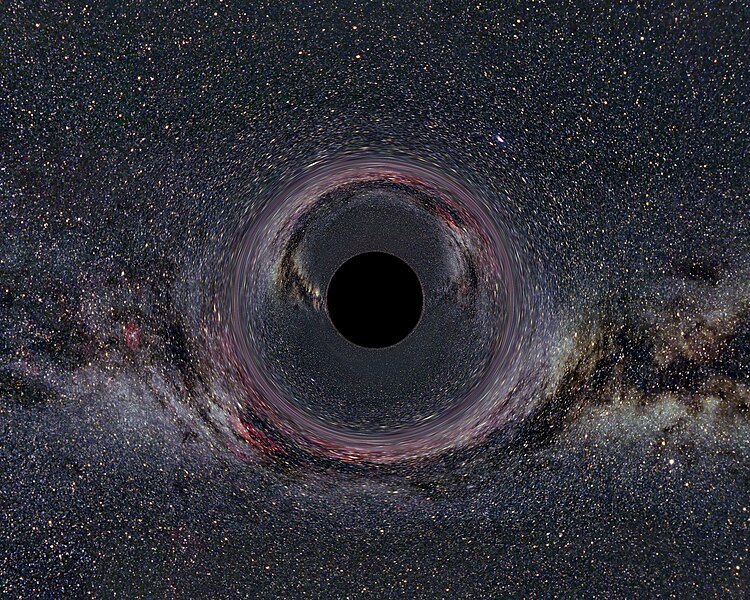
Caption: "A simulated isolated stellar-mass black hole of 10 solar masses as seen from a distance of 600 km with the Milky Way in the background."
Features:
- Yours truly takes it on faith that the image is accurate and
assumes the black hole
is a
Schwarzschild black hole:
i.e., it has
zero
angular momentum
and zero
net electric charge.
- Note that the general
Schwarzschild radius formula R_sch = 2GM/c**2
implies
R_sch = 2.95318 km (M/M_☉) ≅ 3 km (M/M_☉) ,
and so the black hole in the image has R_sch ≅ 30 km. The Schwarzschild radius is the radius of the event horizon. See also black_hole_schwarzschild_radius_formulae.html.
- But we are NOT seeing the
event horizon as the
black
circle.
The black
circle
is black hole shadow.
To elucidate, see the figure below
(local link /
general link: black_hole_shadow.html).
- We see the (simulated isolated stellar-mass black hole) black hole (i.e., its black hole shadow) in the image because we are so close and the black hole is isolated from any other sources.
- Also the black hole causes strong gravitational lensing of the Milky Way which is the background of the image.
- The circular pattern is an imperfect Einstein ring.
Albert Einstein (1879--1955) predicted that a point source of light directly behind a spherically symmetric gravitational well would be gravitational lensed into a ring image.
Any deviation from spherically symmetry of the gravitational well and axial symmetry of the source causes distortions from the perfect Einstein ring pattern. Near perfect Einstein rings have been observed---but NOT from gravitational wells that are black hole candidates as far as knows yours truly.
- Isolated stellar mass black hole can be detected as gravitational lenses. There is NO resolution of the image of the background source, but there is an amplification of the light from said background source. But in such cases it is hard to distinguish black holes from other dim astronomical objects: e.g., dim normal stars, brown dwarfs, white dwarfs, and neutron stars.
- Can we ever resolve a black hole shadow (and so infer an event horizon) and see a black hole as a black hole?
For stellar-mass black holes, this seems very unlikely. They are all much too far away and too small to resolve.
But we can resolve supermassive black holes (i.e., their black hole shadows) in the radio. This was done for the first time for the supermassive black hole M87* at the center of galaxy M87 (NGC 4486) in 2019 by the Event Horizon Telescope (EHT). The EHT is currently trying to resolve the Sagittarius A* which is the supermassive black hole at the Milky Way center (AKA Galactic center of mass approximately).
- We see the (simulated isolated stellar-mass black hole) black hole (i.e., its black hole shadow) in the image because we are so close and the black hole is isolated from any other sources.
Image link: Wikipedia: File:Black Hole Milkyway.jpg.
Local file: local link: black_hole_isolated_up_close.html.
File: Black hole file: black_hole_isolated_up_close.html.